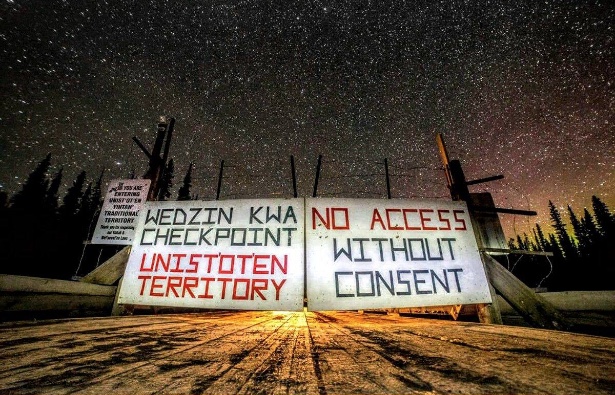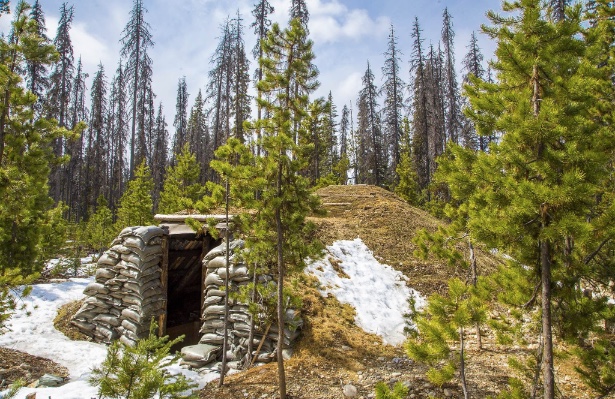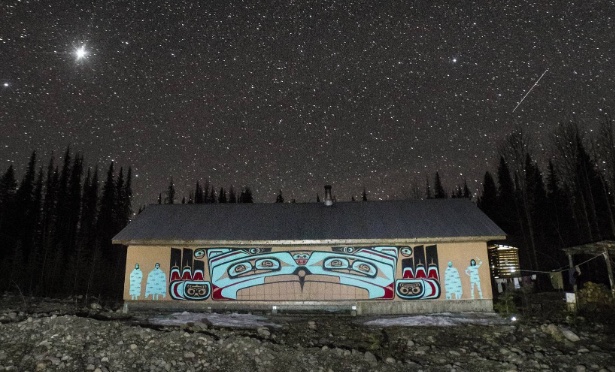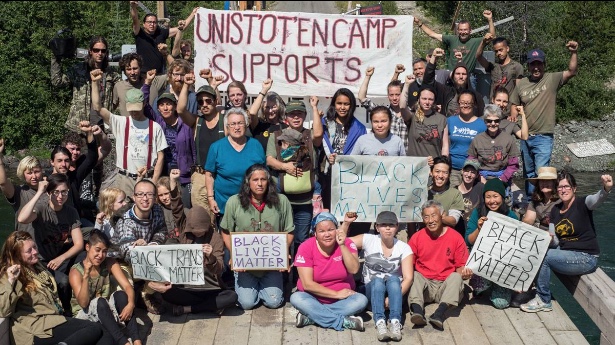
Source: Waging Nonviolence
The Standing Rock standoff over the Dakota Access Pipeline was a reminder that colonization, and resistance to it, both exist in the present tense. Fossil fuel pipelines that despoil indigenous lands and waters have become key flashpoints in long-standing anti-colonial resistance.
An important precursor and inspiration for the Standing Rock camp is an indigenous occupation in northern British Columbia, Canada. For the past eight years, the Unist’ot’en clan have reoccupied their traditional territory. When the camp began in 2009, seven pipelines had been proposed to cross their territory, as well as their water source, the salmon-bearing Morice River. But thanks to Unist’ot’en resistance, oil and gas companies have been blocked from building new fossil fuel infrastructure. The lesser known but wildly successful Unist’ot’en encampment holds crucial lessons for anti-pipeline and anti-colonial organizers across North America, or Turtle Island, as many indigenous nations call it.
We visited the occupation this summer. Upon arriving, visitors must undergo a border-crossing protocol. There is only one way in and out of Unist’ot’en territory – a bridge that crosses the Morice River. Before being allowed to cross, we were asked where we came from, whether we worked for the government or the fossil fuel industry, and how our visit could benefit the Unist’ot’en.
We explained that we are both settlers, people living on and benefiting from indigenous lands. We also expressed our willingness to help in whatever ways were needed during our stay, such as kitchen duty, gardening and construction. Finally, we shared our commitment to decolonization and climate justice, and our appreciation for how Unist’ot’en land defense accomplishes both; it returns indigenous lands to indigenous peoples while blocking fossil fuel infrastructure that threatens the entire human estate. After a short consultation, clan members welcomed us to leave Canada and cross into Unist’ot’en territory.
Five pipelines already defeated
The Unist’ot’en occupation has already contributed to the cancellation of five pipelines, including Enbridge’s Northern Gateway project – a multibillion-dollar development that would have pumped bitumen from Alberta’s tar sands to Canada’s Pacific coast. The two proposed incursions onto Unist’ot’en territory that remain are both fracked gas pipelines: Chevron’s Pacific Trails and TransCanada’s Coast Gaslink.
Unist’ot’en spokesperson Freda Huson explained to us that the tireless work of supporters, including indigenous people from other nations along with settler allies, is a central reason why the camp has endured and grown, knocking pipeline proposals over one by one.
Despite these successes, Huson has been struck by the exhaustion of frontline occupiers — not just on the Unist’ot’en front line, but elsewhere, including Standing Rock. Since starting their occupation, the Unist’ot’en have hosted an annual action camp for supporters wanting to learn about the struggle. Huson dedicated this year’s action camp to the theme of healing. As she explained to us, “the health of the people is vital to keep the resistance moving forward. We believe that if we heal the people they will be healthy to make decisions to heal the land.”
The action camp as a place of healing
This year’s action camp featured workshops on burnout, healing from trauma, indigenous approaches to conflict resolution, and, on the first day, an exercise in awareness.
This first activity was facilitated by Huson and her partner Smogelgem (a hereditary chief of the neighboring Likhts’amisyu Clan). During this exercise, we were blindfolded, spun around and then guided by a partner to a tree of their choosing. “Be with the tree, make a connection” were the simple instructions. After our partners returned us to our starting points, we removed our blindfolds and went searching for our newfound evergreen friend. Every single participant found their tree. Smogelgem then explained that the land is living and breathing. We are always in relationship to it, but our relations to the land can be intentionally deepened, so that we come to experience trees, water and animals as friends, even kin.

After completing the workshop, we walked to a traditional pithouse that was recently built on the precise GPS coordinates of Chevron’s proposed pipeline. Huson and Smogelgem plan to live in the pithouse once it is complete (and outfitted with comfortable furnishings and energy-efficient lighting and appliances). Their vision is for more Wet’suwet’en people to join them back on the land, living and renewing their culture. The Wet’suwet’en Nation is comprised of five clans, including the Unist’ot’en people.
Once the two remaining pipeline threats are defeated, Huson and Smogelgem will transition the camp into a full-time healing and cultural center for indigenous people recovering from the ongoing trauma of colonization. Indeed, the largest structure at the camp, a three-story building that includes a dining hall, industrial kitchen, and counseling spaces, is called “The Healing Centre.”
The Unist’ot’en Camp has always had a dual purpose: resisting pipelines while nurturing Wet’suwet’en culture. Like the water protectors at Standing Rock, the Unist’ot’en Clan has been careful to clarify that their settlement is not a protest. Rather, it is an occupation and assertion of their traditional territory — a site from which to resist further colonial extraction, while also practicing a culture and economy that is inseparable from the land.
According to Huson, “our people’s belief is that we are part of the land. The land is not separate from us. The land sustains us. And if we don’t take care of her, she won’t be able to sustain us.”
Huson explained to us that she lived away from her people’s territory for 20 years due to colonization. “I lived on reservation, got educated and worked as an economic development officer for 14 years,” she said. “Once I decolonized and reconnected to my territory, I felt my spirit come alive. When family visit, they don’t want to leave.” She wants to share with others the healing that she has experienced by being back out on her people’s land.
Indigenous resurgence and embodied social change
The Unist’ot’en Camp is exemplary of what indigenous scholars such as Leanne Betasamosake Simpson and Jeff Corntassel (Nishnaabeg and Cherokee ancestry, respectively) call “indigenous resurgence.” According to Corntassel: “Being indigenous today means struggling to reclaim and regenerate one’s relational place-based existence by challenging the ongoing destructive forces of colonization.” He notes that ceremony is a key way to “reconnect to the natural world.”
There are deep resonances between indigenous resurgence and the focus on ceremony, mindfulness and healing practices that are emerging in radical social movements across Turtle Island. Settler activists are finding that different healing practices, such as meditation and yoga, can help reduce burnout, heal the traumas caused by oppression and increase organizational effectiveness. Daily meditations, for example, played an important role at Occupy Wall Street. These resonances between indigenous resurgence and the growing social movement interest in non-Western healing practices have the potential to facilitate new solidarities between indigenous activists and settler allies.
For example, Hajime Harold is a teacher, activist and longtime supporter of Unist’ot’en land defense. During this year’s action camp, he led daily exercises in qigong, a traditional Chinese healing system that integrates breathing, meditation and physical postures. As a Japanese Canadian, Harold experienced racism growing up in Kelowna, British Columbia. These painful experiences sensitized him to injustices, including those related to colonialism. His heart has been opened, too, he said, by learning qigong, which has increased his capacity to act in solidarity with those whose challenges are different from his. For Harold, qigong helps practitioners better connect with themselves, other people and the earth. He experiences qigong as resonant with the indigenous traditional teachings that he is familiar with.
Similarly, scholar Michael Yellow Bird (from the Sahnish and Hidatsa Nations) sees indigenous ceremonial practices as aligned with mindfulness meditation, and crucial to what he terms “neurodecolonization,” or transforming the embodied traumas that colonialism leaves in its wake.
Building settler solidarity on stolen native land
Despite the similarities between indigenous resurgence and mind-body practices of settler social movements, there is still a vital element of decolonization that is regularly missed by settler activists: land. To whom does the land rightfully belong? Who has decision-making power over it?
Over lunch at the Unist’ot’en Camp, indigenous scholar Edward Valandra (from the Oceti Sakowin Oyate) asked us a simple question: “What is the first thing you do when you get out of bed each morning?” We immediately thought of our various morning rituals (meditation, yoga, a cup of coffee). Valandra patiently watched as we pondered his question; then he leaned in. “I can tell you exactly what you do each morning. You step out of bed onto stolen native land.”
The regular failure of settler activists to grapple with the land question means that even radical social movements are constantly at risk of reinforcing colonial structures and social relations. Consider Occupy Wall Street. The different occupations that sprang up across the continent in 2011 to protest profound disparities in wealth rarely acknowledged that they were happening on already occupied land. Moreover, as scholars Eve Tuck (member of the Aleut indigenous community) and K. Wayne Yang have argued, “the ideal of ‘redistribution of wealth’ camouflages how much of that wealth is land, Native land.” Without a focus on the repatriation of land to indigenous peoples, a seemingly radical call for redistribution can quickly become a continuation of colonial dispossession.
Decolonization may feel unsettling to some, as it means the return of land and governing authority and the renunciation of settler privileges. Nevertheless, indigenous-led front lines from Standing Rock to Unist’ot’en are drawing a growing number of settlers who grieve colonial injustices, feel anxious about climate destabilization and crave a deeper connection to the land upon which they live.
Julia Michaelis is the camp’s chef. If food critics visited front lines, the kitchen at Unist’ot’en would be brimming with five-star reviews. Julia explained to us that she loved being at camp because every step she takes while there — from chopping onions to facilitating nonviolent direct action trainings — is in the service of decolonization. For settlers, relating to the magnitude of colonial injustice can be overwhelming. But at a front line like the Unist’ot’en camp, a simple chore like washing dishes is transformed into an everyday act of decolonization.

In a blog post about his experiences of healing at the camp, settler activist Will Falk recently reflected on how “every chore, every conversation, every action at the camp comes with a fullness of meaning I have never found anywhere else.” For Falk, this meaning is rooted in the traditional teachings that inform the camp.
According to Unist’ot’en Clan member Karla Tait, many supporters (both indigenous and settler) have “come out to Unist’ot’en land and found it to be a healing experience, to live on the land and have a connection with the natural world and our teachings.”
Supporters at the camp are making a connection with Unist’ot’en people, whose ancestors have been in deep relationship with the land since time immemorial. Being in good relations with people whose living traditions emerge from thousands of years of reciprocal relationship with the land allows for a depth of environmental connection, a groundedness on the Earth, that many supporters have never before experienced.
As environmental educators, we have learned a variety of contemplative exercises designed to deepen human connection to the land and facilitate a desire for stewardship. But we learned at the Unist’ot’en Camp that there is no substitute for the groundedness that comes from being in good relationship with the specific peoples upon whose lands you are living. Developing that relationship means fighting for the restitution of indigenous lands and authority.
Post-colonialism?
The Unist’ot’en Camp offers a glimpse into what post-colonial relations between indigenous peoples and settlers could look like on Turtle Island. The land is Wet’suwet’en territory and governed by Wet’suwet’en law and systems of governance, but the camp welcomes visitors of all backgrounds who are keen to respect, abide by and learn from the laws of the land.

As stated on the Unist’ot’en website: “People of all races, religions, nationalities, classes, genders, orientations and gender identifications are welcome to support the grassroots Wet’suwet’en people in defending their land.” This connection across difference is practiced actively, a key part of the healing ethos of the camp. Indeed, one of our favorite activities at camp was “Femme Friday,” when everyone was encouraged to wear makeup and nail polish to make the environment more welcoming and celebratory for two-spirit people and genderqueer allies. Indigenous resurgence can look like a hereditary chief in red nail polish.
After eight years of anti-colonial resistance and the defeat of multiple pipeline projects, the Unist’ot’en Camp is still building momentum. Their winning formula is this: indigenous land governed by indigenous people, with consistent support from settler allies. This approach, deployed at Standing Rock and other indigenous-led front lines, is helping to ensure a livable future by stopping the construction of new fossil fuel infrastructure, while also sowing seeds for a different world — one in which the deep wounds to land and people inflicted by colonialism can finally heal.
James Rowe is an Associate Professor of Environmental Studies at the University of Victoria. He is completing a book — Radical Mindfulness — that examines the political potential of mind/body practices like meditation. Mike Simpson is a visiting Fulbright scholar at the University of Minnesota researching pipeline conflicts in North America.
